2022 Robotics Survey: The logistics robots have arrived
A new Peerless Research Group report takes an inside look at how companies are investing in robotics, how they’re putting the systems to use, and what their future robotics plans include.

The optimization, integration, automation and management of material goods and data within the four walls of a warehouse or distribution center (DC), intralogistics has been getting a lot of attention lately due to the ongoing impacts of the pandemic, the growing labor shortage, the uptick in e-commerce orders and ever-evolving consumer preferences.
The exhibition hall at the recent Modex trade show, one of the leading materials handling events in the world, brought the current state of warehouse robotics and automation into clear focus, all under one roof. There, hundreds of vendors from all corners of the materials handling world were showcasing their innovations, most of which were in some way—either directly or indirectly—related to automation and robotics.
Are you currently using or consideringother types of large-scale intralogisticsautomation like conveyors, sortation,storage/retrieval, or shuttle systems?
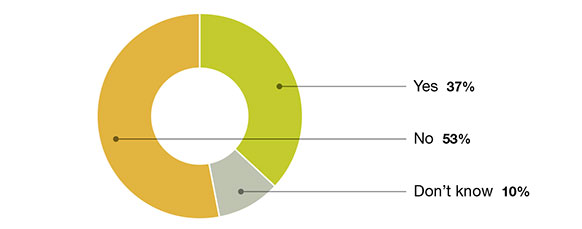
The long line of attendees waiting to get onto that floor each morning of the four-day event further proved just how hungry logistics operations are for equipment, software, devices and tools that help them get more done with less.
Once inside the exhibition hall, those attendees visited spacious booths outfitted with the newest warehouse robotics; watched robots effectively take on the “heavy lifting” involved with picking and packing orders; and saw how robotics developers and container manufacturers are collaborating to make combined solutions that work in perfect harmony.
With the global robotics market on track to grow to $45.5 million this year—and with 80% of current fulfillment centers lacking any type of automation—companies across all industries are experimenting with and implementing robotics in their warehouses, DCs and fulfillment centers. Supporting this trend is a vendor base that’s optimizing advanced technology and using it to develop newer, better and more useful machines that meet their own customers’ needs.
What best describes your organization’s use of robotic automation systems and/or autonomous mobile robots in your warehouses, distribution centers and/or manufacturing operations?
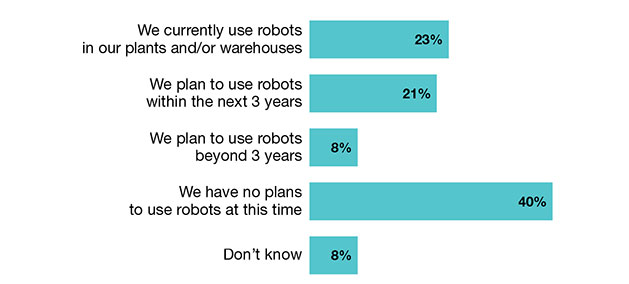
“Mobility underpins increased robotics usefulness, as contemporary robots are equipped with sensors such as light detection and ranging [Lidar] sensors and computer vision to help them autonomously navigate their environments,” PitchBook, a capital market company, points out in its recent robotics report. “This new ability, combined with labor shortages, geopolitical concerns, and productivity-obsessed shareholders, has many companies looking to robots to accelerate their business competitiveness.”
To learn more about current and future intralogistics robotics and automation implementation trends—including readiness for adoption, barriers to adoption, and the key criteria shippers are using when buying such equipment—Peerless Research Group (PRG) recently conducted its new “Intralogistics Robotics Study” in March of 2022. Here’s what we learned.
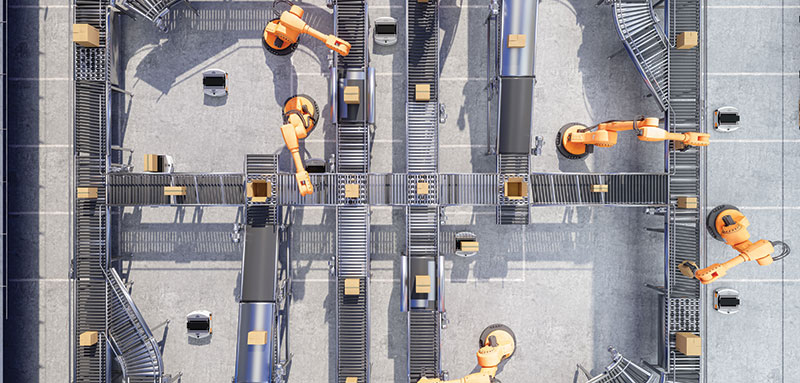
The breakdown
Which of the following use cases would be your top 3 priorities for using robots today?
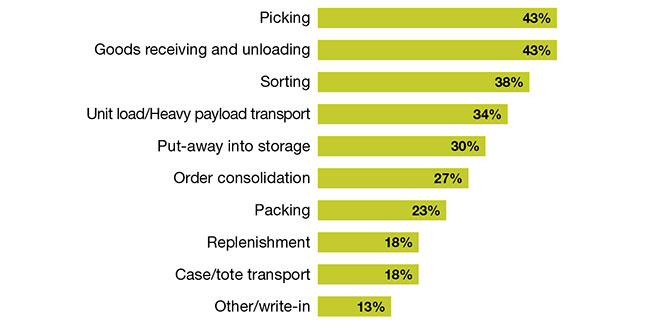
More than 300 Logistics Management and Modern Materials Handling readers provided input for the online survey, which was largely focused on the current state of robotics automation adoption and use cases.
Responsible for hiring, interviewing or sourcing full-time or part-time labor to manage materials handling, distribution and fulfillment, the survey respondents work in manufacturing (41.8%); transportation and warehousing services (15.3%); wholesale trade (10.2%); and retail trade (8.2%) industries.
The key industry sectors represented for this survey include fabricated metals, industrial machinery, and plastics and rubber. The majority of companies (38.8%) have annual revenues of less than $50 million, while 11.2% have somewhere between $100 million to $249.9 million in revenues and another 9.2% reported revenues of $2.5 billion or more.
Beginning their journeys
Many companies are just beginning their warehouse robotics journeys, according to the survey. In fact, we found that 40.4% have yet to install any robotic automation systems or services. About 34% of respondents consider themselves “potential buyers” or “current users” of these solutions, while 15.2% provide robotic automation consulting and systems integration services and 7.3% sell robotic automation systems or services.
What is your preferred commercial model for your planned robotics initiatives?
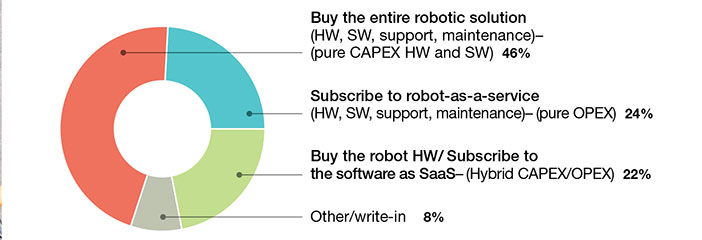
Currently, 37% of companies are using large-scale intralogistics automation (e.g., conveyors, sortation, storage/retrieval, or shuttle systems) in their operations, and 23.1% are using robots in their plants or warehouses. Just over half of the responding organizations (52.8%) are not using this type of equipment, but 21.3% plan to put it to use within the next three years.
About 40% of survey respondents still say that they have “no plans to use robots at this time.”
When asked for their top reasons for not investing in robotics, respondents said they were going to focus their time and investments in warehousing and storage; order customization; inventory management; and individual pick, pack and ship. Other obstacles include a lack of management support, too many variables in products, space and cost constraints and inventory fluctuations.
Planning ahead now
Of the survey respondents who plan to use robots, but don’t currently have them in place, 38% of respondents are in the education and knowledge gathering stage; 22% are in the strategy and vision formulation stage; and 12% plan to roll out additional robots based on previous, successful tests. Other respondents are conducting an impact analysis (8%), documenting requirements (4%), piloting (2%), or already implementing robots in the live
production environment (2%).
How important are the following business case factors when you are choosing your robotics solutions?
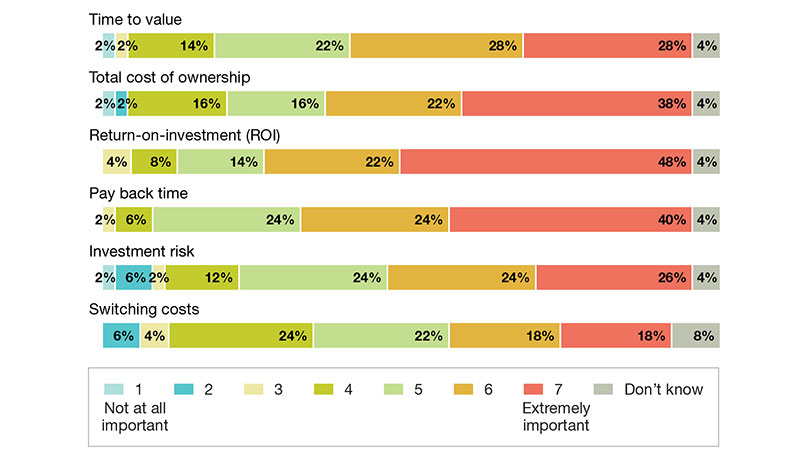
The companies that are implementing robotics and automation are focused on increasing flow and throughput, better managing the labor crisis, improving current labor productivity, reducing labor costs, improving workplace safety, reducing injuries and improving order accuracy and quality.
When selecting and implementing advanced robotics automation to fulfill those needs, most companies turn to material handling suppliers, robotics vendors, industry peers or systems integrators for help.
According to respondents who are planning to implement robotics automation, their top priorities for using such technology include picking (42.9%), goods receiving and unloading (42.9%) and sorting (37.5%). About 43% of companies are considering AMR pallet movement equipment while 34% want autonomous retrieval-to-person/put-wall robots, and 30.2% are evaluating robotic picking systems.
Around 28% of respondents want to incorporate heavy payload forked/tugger transport robots into their operations, while 24.5% and 22.6% want sortation robots or stationary industrial robots, respectively. Other types of automated equipment that are currently on logistics operations’ radar screens include heavy payload carry-on-top transport robots, case/tote transport robots, collaborative in-aisle picking robots and cleaning robots.
ROI wanted
When choosing a robotics solution, 48% of companies say ROI is extremely important to their decision making, while 40% see payback time as extremely important and 38% point to total cost of ownership as a key aspect of their decision-making process. Additionally, 28% consider time to value when choosing a solution, and 26% consider investment risk extremely important.
What is the current state of your organization’s pursuit of robots in your warehouse or DCs?
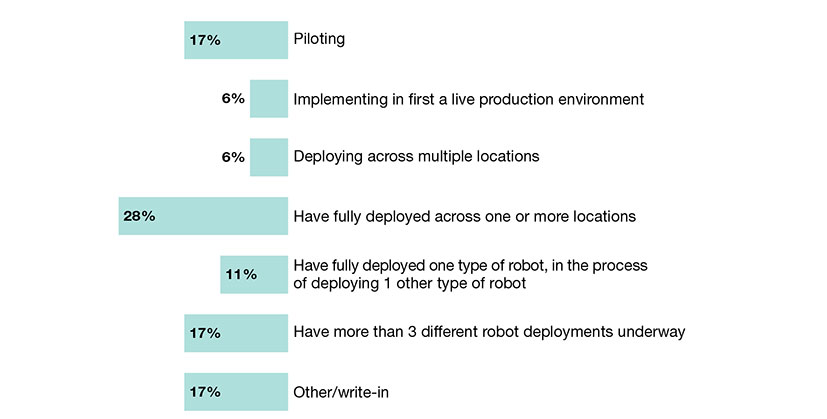
Of those companies planning to implement a robotics solution, 32% have yet to secure the funding for these projects, but are working on it, while 24% do have the funding in place. About 10% of respondents say that pre-funding is unnecessary because they plan to use robots as a service (RaaS) and another 2% say they plan to funnel funds from other projects into their robotics and automation initiatives.
Nearly half of the survey respondents who are planning to use robotics would prefer to buy the entire robotic solution (i.e., a pure Capex investment); 24% say they would rather use the RaaS option; and 22% say they would prefer to buy the robot hardware but subscribe to the software via a hybrid approach.
Customer satisfaction guaranteed
When investing in robotics solutions, more than half of respondents (53.8%) say payback is an “extremely important” factor in the decision, while an equal number consider return on investment (ROI) when making these decisions. Others point to time to value (38.5%), total cost of ownership (38.5%), and investment risk (30.8%) as some of the most important considerations when investing in robotics and automation.
Which use cases are you addressing with robots today?
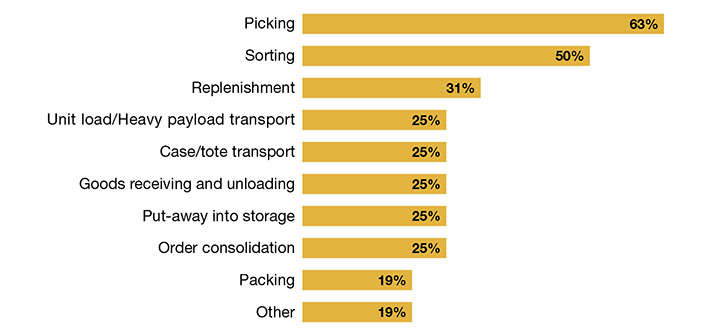
Robots are living up to expectations in the real-world applications where they’re being put to work. Asked whether their existing robotics installations lived up to early expectations, over 60% of companies say their total-cost-of-ownership objectives were either met or exceeded. Nearly 85% of respondents say that the projected ROI either met or exceeded their expectations, and almost 77% say the same about their payback time objectives.
Overall, the majority of companies are satisfied with their robotics and automation investments, with 69.2% of them reportedly achieving their overall business goals from their robotics implementations, 23.1% saying they’ve yet to achieve those goals and 7.7% unsure of the answer to that question.
More robots, please
Organizations are enthusiastic about future use cases for robotic automation. Nearly all of those with robotics systems currently in place say they have plans for future projects, while 46.2% say they’re already in the middle of new projects. Just over 46% will pursue new use cases over the next two years (with the planning process already underway), while 7.7% have no plans to implement robotics in their intralogistics operations.
Did you achieve your overall business goals from your robotics investment?
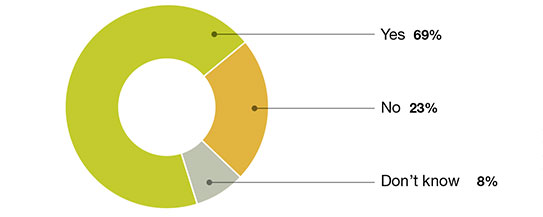
When planning out future robotics projects, about 77% of respondents say picking is their top priority, while 46.2% point to sorting, 38.5% to case/tote transport, and 30.8% to replenishment as their key priorities. Other companies want to add more robotics into their goods receiving and unloading processes (30.8%); put-away into storage automation (15.4%); packing (7.7%); and order consolidation (7.7%).
Looking ahead, 61.5% of survey respondents will likely consider mobile goods-to-person systems within the next two to five years, while 53.8% point to robotic picking systems and 46.2% to sortation robots as their key future priorities. About 39% of respondents have set their sights on autonomous retrieval-to-person/put-wall robots, 30.8% want stationary industrial robots and 30.8% will be considering heavy payload carry-on-top transport robots.

Article Topics
Magazine Archive News & Resources
Latest in Materials Handling
Beckhoff USA opens new office in Austin, Texas Manhattan Associates selects TeamViewer as partner for warehouse vision picking ASME Foundation wins grant for technical workforce development The (Not So) Secret Weapons: How Key Cabinets and Asset Management Lockers Are Changing Supply Chain Operations MODEX C-Suite Interview with Harold Vanasse: The perfect blend of automation and sustainability Consultant and industry leader John M. Hill passes on at age 86 Registration open for Pack Expo International 2024 More Materials HandlingAbout the Author
Subscribe to Materials Handling Magazine

Find out what the world's most innovative companies are doing to improve productivity in their plants and distribution centers.
Start your FREE subscription today.
April 2024 Modern Materials Handling

Latest Resources










